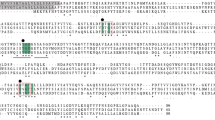Abstract
A microbial peptide amidase was found in a limited screening and purified about 500-fold from Stenotrophomonas maltophilia. The native enzyme has a molecular mass of 38 kDa (gel filtration). The sequence of the first 16 amino acids was determined by Edman degradation. The isoelectric point was found to be around 5.8. The peptide amidase exhibited a pH optimum of 6.0 and a temperature optimum of about 39–45°C. The enzyme is stable in 50 mM TRIS/HCl, pH 7.5, at 30°C, and the residual activity was found to be above 90% after 1 week of incubation. The biocatalyst is not inhibited by potential inhibitors like Hg2+, EDTA, d-cycloserine or dithiothreitol and only weakly influenced by inhibitors of serine proteases. The peptide amidase deamidates selectively C-terminal amide groups in peptide amides without hydrolysing internal peptide bonds or amide functions in the side-chain of glutamine or asparagine. Unprotected amino acid amides are not hydrolysed. The enzyme is stereoselective with regard to l-enantiomers in the C-terminal position.
Similar content being viewed by others
References
Beckers G (1992) Kinetische Untersuchung der Peptidamidase aus Orangen. Diplomarbeit Heinrich-Heine-Univeristät, Düsseldorf
Bergmeyer HU, Beutler HO (1985) Ammonia. In: Bergmeyer HU (ed) Methods of enzymatic analysis, vol 8. Verlag Chemie, Weinheim, pp 454–461
Bradford MM (1976) A rapid and sensitive method for the quantitation of microgram quantities of protein utilizing the principle of protein-dye binding. Anal Biochem 72:248–254
Breddam K (1986) Serine carboxypeptidases. Carlsberg Res Commun 51:83–128
Dey ES, Aasmul-Olsen S (1993) Novel serine penicillocarboxypeptidase CPD-S3 from Penicillium janthinellum IBT 3991: purification, characterization, and uses in peptide synthesis and modification. Enzyme Microb Technol 15:1042–1050
Edman P (1967) A protein sequenator. Eur J Biochem 1:80–91
Hummel W, Kula M-R (1989) Simple method for small-scale disruption for bacteria and yeasts. J Microbiol Methods 9:201–209
Jakubke H-D, Jeschkeit H (1982) Aminosäuren, Peptide und Proteine. Verlag Chemie, Weinheim
Joeres U, Kula M-R (1994) Screening for a novel enzyme hydrolsing l-carnitine amide. Appl Microbiol Biotechnol 40:599–605
Kammermeier-Steinke D, Schwarz A, Wandrey C, Kula M-R (1993) Studies on the substrate specificity of a peptide amidase partially purified from orange flavedo. Enzyme Microb Technol 15:764–769
Kamphius J, Hermes HFM, Balken JAM van, Schoemaker HE, Boesten WHJ, Meijer EM (1990) Chemo-enzymatic synthesis of enantiomerically pure α-H and α-alkyl α-amino acids and derivatives. In: Lubec G, Rosenthal G (eds) Amino acids: chemistry, biology, medicine. ESCOM, Leiden, pp 119–125
Krix G (1995) Enzymatische Synthese von l-α-Aminosäuren und Dipeptiden. Dissertation Heinrich-Heine-Universität, Düsseldorf
Laemmli UK (1970) Cleavage of structural proteins during assembly of the head of bacteriophage T4. Nature 227:680–685
Schlegel HG (1985) Allgemeine Mikrobiologie. Thieme, Stuttgart, p 174
Schwarz A, Steinke D, Kula M-R, Wandrey C (1992) A two-step enzymatic synthesis of dipeptides. Biotechnol Bioeng 39:132–140
Steinke D, Kula M-R (1990) Selective desamidation of peptide amides. Angew Chem Int Ed Engl 29:1139–1140
Stelkes-Ritter U (1994) Reinigung, Charakterisierung und Anwendung der Peptidamidasen aus Citrus sinensis L. und Stenotrophomonas maltophilia. Dissertation Heinrich-Heine-Universität Düsseldorf
Stelkes-Ritter U, Wyzgol K, Bommarius AS, Schwarm M, Drauz K, Kula M-R (1994) Characterization of a newly screened microbial peptide amidase. In: Wünsch E (ed) Proceedings of the 5th Akabori Conference. Max-Planck-Gesellschaft, Munich, pp 66–69
Waldman H (1991) Enzymatic protecting group techniques. Kontakte (Darmstadt) 2:233–254
Author information
Authors and Affiliations
Rights and permissions
About this article
Cite this article
Stelkes-Ritter, U., Wyzgol, K. & Kula, MR. Purification and characterization of a newly screened microbial peptide amidase. Appl Microbiol Biotechnol 44, 393–398 (1995). https://doi.org/10.1007/BF00169934
Received:
Accepted:
Issue Date:
DOI: https://doi.org/10.1007/BF00169934




